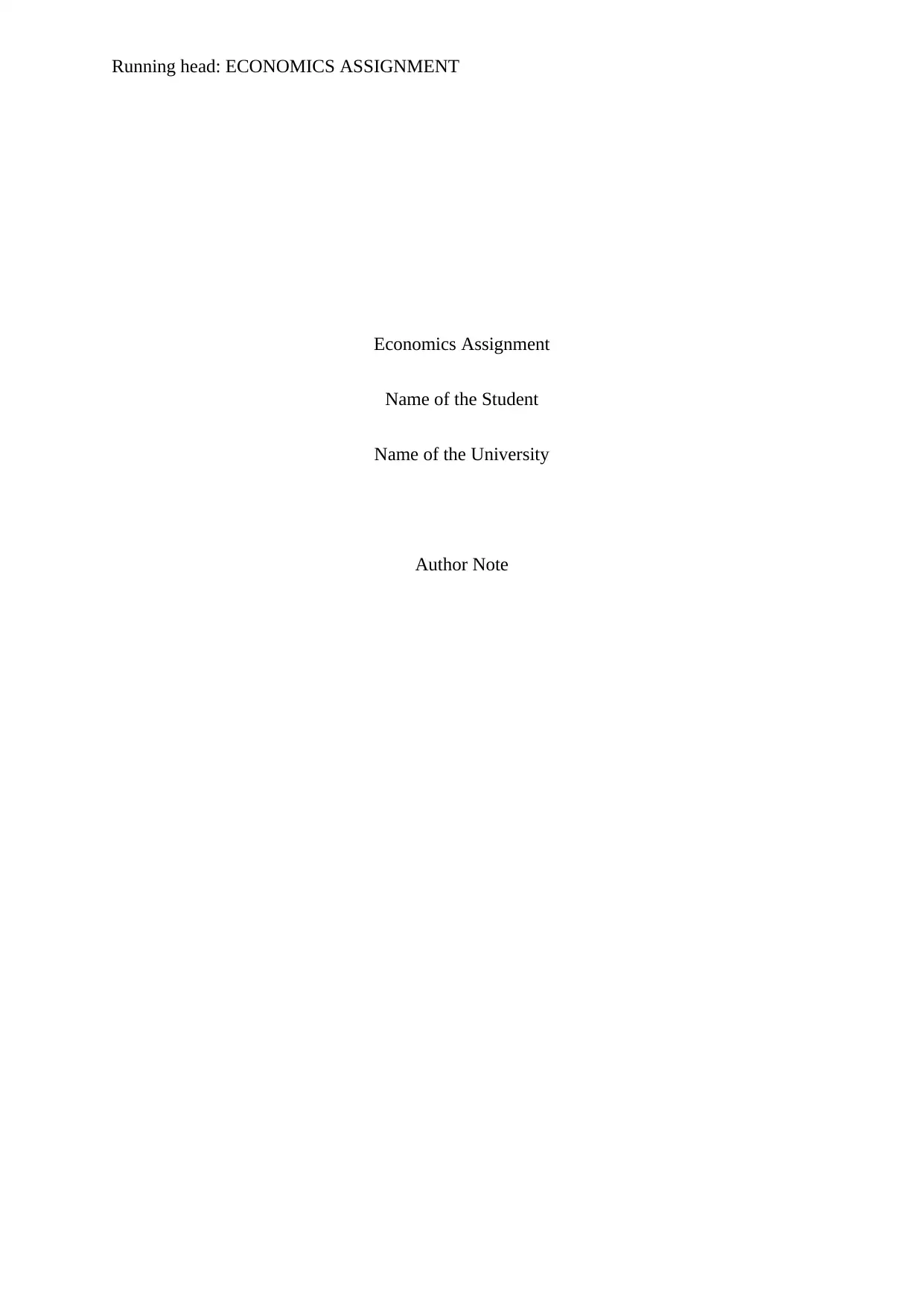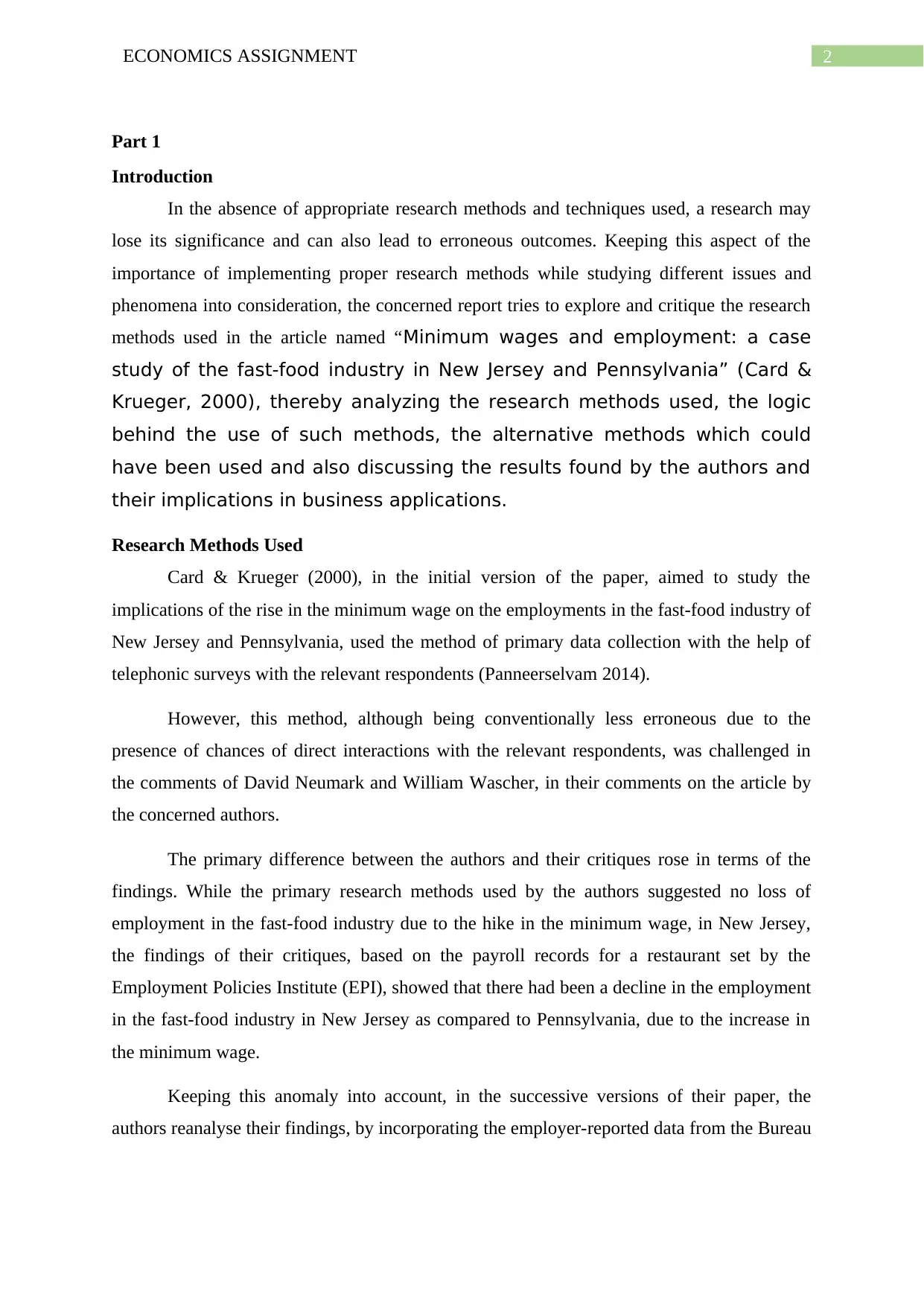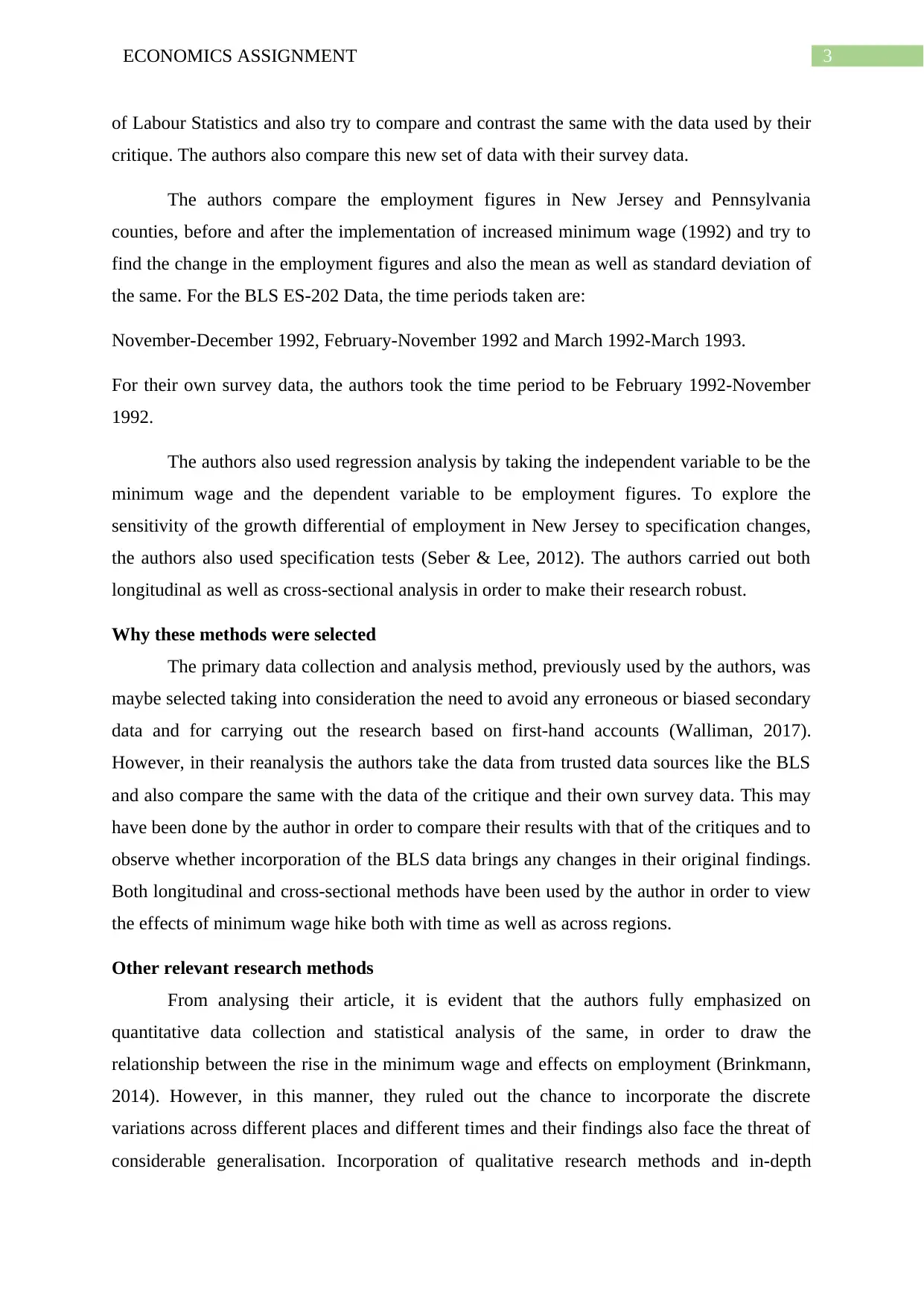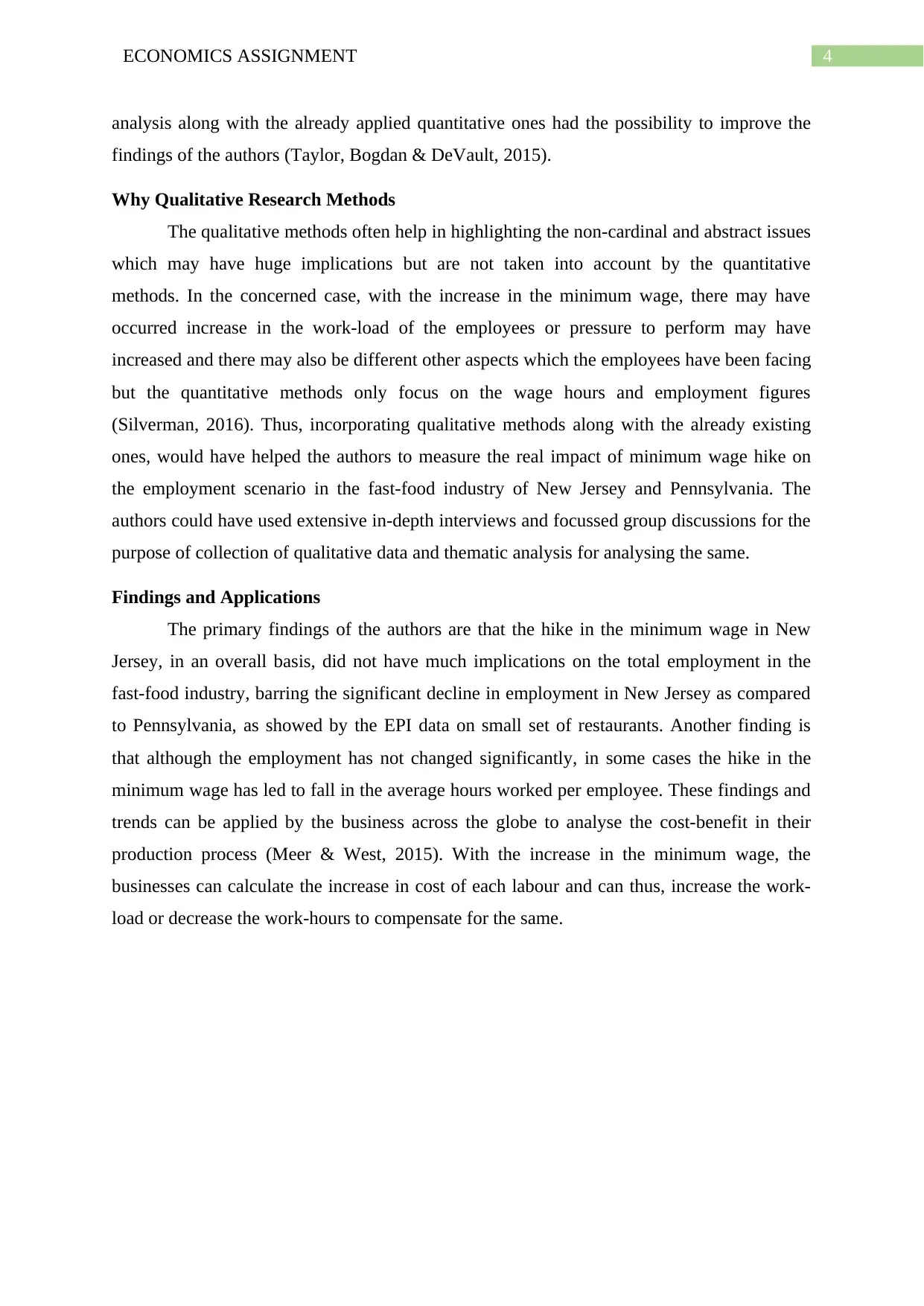Critique of Research Methods Used in Minimum Wages and Employment Study
VerifiedAdded on 2023/06/10
|6
|1450
|463
AI Summary
This report critiques the research methods used in the study on minimum wages and employment in the fast-food industry in New Jersey and Pennsylvania. It analyzes the methods used, their logic, and alternative methods that could have been used. The report also discusses the findings and their implications in business applications.
Contribute Materials
Your contribution can guide someone’s learning journey. Share your
documents today.

Running head: ECONOMICS ASSIGNMENT
Economics Assignment
Name of the Student
Name of the University
Author Note
Economics Assignment
Name of the Student
Name of the University
Author Note
Secure Best Marks with AI Grader
Need help grading? Try our AI Grader for instant feedback on your assignments.

1ECONOMICS ASSIGNMENT
Table of Contents
Part 1..........................................................................................................................................2
Introduction............................................................................................................................2
Research Methods Used.........................................................................................................2
Why these methods were selected..........................................................................................3
Other relevant research methods............................................................................................3
Why Qualitative Research Methods.......................................................................................4
Findings and Applications......................................................................................................4
References..............................................................................................................................5
Table of Contents
Part 1..........................................................................................................................................2
Introduction............................................................................................................................2
Research Methods Used.........................................................................................................2
Why these methods were selected..........................................................................................3
Other relevant research methods............................................................................................3
Why Qualitative Research Methods.......................................................................................4
Findings and Applications......................................................................................................4
References..............................................................................................................................5

2ECONOMICS ASSIGNMENT
Part 1
Introduction
In the absence of appropriate research methods and techniques used, a research may
lose its significance and can also lead to erroneous outcomes. Keeping this aspect of the
importance of implementing proper research methods while studying different issues and
phenomena into consideration, the concerned report tries to explore and critique the research
methods used in the article named “Minimum wages and employment: a case
study of the fast-food industry in New Jersey and Pennsylvania” (Card &
Krueger, 2000), thereby analyzing the research methods used, the logic
behind the use of such methods, the alternative methods which could
have been used and also discussing the results found by the authors and
their implications in business applications.
Research Methods Used
Card & Krueger (2000), in the initial version of the paper, aimed to study the
implications of the rise in the minimum wage on the employments in the fast-food industry of
New Jersey and Pennsylvania, used the method of primary data collection with the help of
telephonic surveys with the relevant respondents (Panneerselvam 2014).
However, this method, although being conventionally less erroneous due to the
presence of chances of direct interactions with the relevant respondents, was challenged in
the comments of David Neumark and William Wascher, in their comments on the article by
the concerned authors.
The primary difference between the authors and their critiques rose in terms of the
findings. While the primary research methods used by the authors suggested no loss of
employment in the fast-food industry due to the hike in the minimum wage, in New Jersey,
the findings of their critiques, based on the payroll records for a restaurant set by the
Employment Policies Institute (EPI), showed that there had been a decline in the employment
in the fast-food industry in New Jersey as compared to Pennsylvania, due to the increase in
the minimum wage.
Keeping this anomaly into account, in the successive versions of their paper, the
authors reanalyse their findings, by incorporating the employer-reported data from the Bureau
Part 1
Introduction
In the absence of appropriate research methods and techniques used, a research may
lose its significance and can also lead to erroneous outcomes. Keeping this aspect of the
importance of implementing proper research methods while studying different issues and
phenomena into consideration, the concerned report tries to explore and critique the research
methods used in the article named “Minimum wages and employment: a case
study of the fast-food industry in New Jersey and Pennsylvania” (Card &
Krueger, 2000), thereby analyzing the research methods used, the logic
behind the use of such methods, the alternative methods which could
have been used and also discussing the results found by the authors and
their implications in business applications.
Research Methods Used
Card & Krueger (2000), in the initial version of the paper, aimed to study the
implications of the rise in the minimum wage on the employments in the fast-food industry of
New Jersey and Pennsylvania, used the method of primary data collection with the help of
telephonic surveys with the relevant respondents (Panneerselvam 2014).
However, this method, although being conventionally less erroneous due to the
presence of chances of direct interactions with the relevant respondents, was challenged in
the comments of David Neumark and William Wascher, in their comments on the article by
the concerned authors.
The primary difference between the authors and their critiques rose in terms of the
findings. While the primary research methods used by the authors suggested no loss of
employment in the fast-food industry due to the hike in the minimum wage, in New Jersey,
the findings of their critiques, based on the payroll records for a restaurant set by the
Employment Policies Institute (EPI), showed that there had been a decline in the employment
in the fast-food industry in New Jersey as compared to Pennsylvania, due to the increase in
the minimum wage.
Keeping this anomaly into account, in the successive versions of their paper, the
authors reanalyse their findings, by incorporating the employer-reported data from the Bureau

3ECONOMICS ASSIGNMENT
of Labour Statistics and also try to compare and contrast the same with the data used by their
critique. The authors also compare this new set of data with their survey data.
The authors compare the employment figures in New Jersey and Pennsylvania
counties, before and after the implementation of increased minimum wage (1992) and try to
find the change in the employment figures and also the mean as well as standard deviation of
the same. For the BLS ES-202 Data, the time periods taken are:
November-December 1992, February-November 1992 and March 1992-March 1993.
For their own survey data, the authors took the time period to be February 1992-November
1992.
The authors also used regression analysis by taking the independent variable to be the
minimum wage and the dependent variable to be employment figures. To explore the
sensitivity of the growth differential of employment in New Jersey to specification changes,
the authors also used specification tests (Seber & Lee, 2012). The authors carried out both
longitudinal as well as cross-sectional analysis in order to make their research robust.
Why these methods were selected
The primary data collection and analysis method, previously used by the authors, was
maybe selected taking into consideration the need to avoid any erroneous or biased secondary
data and for carrying out the research based on first-hand accounts (Walliman, 2017).
However, in their reanalysis the authors take the data from trusted data sources like the BLS
and also compare the same with the data of the critique and their own survey data. This may
have been done by the author in order to compare their results with that of the critiques and to
observe whether incorporation of the BLS data brings any changes in their original findings.
Both longitudinal and cross-sectional methods have been used by the author in order to view
the effects of minimum wage hike both with time as well as across regions.
Other relevant research methods
From analysing their article, it is evident that the authors fully emphasized on
quantitative data collection and statistical analysis of the same, in order to draw the
relationship between the rise in the minimum wage and effects on employment (Brinkmann,
2014). However, in this manner, they ruled out the chance to incorporate the discrete
variations across different places and different times and their findings also face the threat of
considerable generalisation. Incorporation of qualitative research methods and in-depth
of Labour Statistics and also try to compare and contrast the same with the data used by their
critique. The authors also compare this new set of data with their survey data.
The authors compare the employment figures in New Jersey and Pennsylvania
counties, before and after the implementation of increased minimum wage (1992) and try to
find the change in the employment figures and also the mean as well as standard deviation of
the same. For the BLS ES-202 Data, the time periods taken are:
November-December 1992, February-November 1992 and March 1992-March 1993.
For their own survey data, the authors took the time period to be February 1992-November
1992.
The authors also used regression analysis by taking the independent variable to be the
minimum wage and the dependent variable to be employment figures. To explore the
sensitivity of the growth differential of employment in New Jersey to specification changes,
the authors also used specification tests (Seber & Lee, 2012). The authors carried out both
longitudinal as well as cross-sectional analysis in order to make their research robust.
Why these methods were selected
The primary data collection and analysis method, previously used by the authors, was
maybe selected taking into consideration the need to avoid any erroneous or biased secondary
data and for carrying out the research based on first-hand accounts (Walliman, 2017).
However, in their reanalysis the authors take the data from trusted data sources like the BLS
and also compare the same with the data of the critique and their own survey data. This may
have been done by the author in order to compare their results with that of the critiques and to
observe whether incorporation of the BLS data brings any changes in their original findings.
Both longitudinal and cross-sectional methods have been used by the author in order to view
the effects of minimum wage hike both with time as well as across regions.
Other relevant research methods
From analysing their article, it is evident that the authors fully emphasized on
quantitative data collection and statistical analysis of the same, in order to draw the
relationship between the rise in the minimum wage and effects on employment (Brinkmann,
2014). However, in this manner, they ruled out the chance to incorporate the discrete
variations across different places and different times and their findings also face the threat of
considerable generalisation. Incorporation of qualitative research methods and in-depth
Secure Best Marks with AI Grader
Need help grading? Try our AI Grader for instant feedback on your assignments.

4ECONOMICS ASSIGNMENT
analysis along with the already applied quantitative ones had the possibility to improve the
findings of the authors (Taylor, Bogdan & DeVault, 2015).
Why Qualitative Research Methods
The qualitative methods often help in highlighting the non-cardinal and abstract issues
which may have huge implications but are not taken into account by the quantitative
methods. In the concerned case, with the increase in the minimum wage, there may have
occurred increase in the work-load of the employees or pressure to perform may have
increased and there may also be different other aspects which the employees have been facing
but the quantitative methods only focus on the wage hours and employment figures
(Silverman, 2016). Thus, incorporating qualitative methods along with the already existing
ones, would have helped the authors to measure the real impact of minimum wage hike on
the employment scenario in the fast-food industry of New Jersey and Pennsylvania. The
authors could have used extensive in-depth interviews and focussed group discussions for the
purpose of collection of qualitative data and thematic analysis for analysing the same.
Findings and Applications
The primary findings of the authors are that the hike in the minimum wage in New
Jersey, in an overall basis, did not have much implications on the total employment in the
fast-food industry, barring the significant decline in employment in New Jersey as compared
to Pennsylvania, as showed by the EPI data on small set of restaurants. Another finding is
that although the employment has not changed significantly, in some cases the hike in the
minimum wage has led to fall in the average hours worked per employee. These findings and
trends can be applied by the business across the globe to analyse the cost-benefit in their
production process (Meer & West, 2015). With the increase in the minimum wage, the
businesses can calculate the increase in cost of each labour and can thus, increase the work-
load or decrease the work-hours to compensate for the same.
analysis along with the already applied quantitative ones had the possibility to improve the
findings of the authors (Taylor, Bogdan & DeVault, 2015).
Why Qualitative Research Methods
The qualitative methods often help in highlighting the non-cardinal and abstract issues
which may have huge implications but are not taken into account by the quantitative
methods. In the concerned case, with the increase in the minimum wage, there may have
occurred increase in the work-load of the employees or pressure to perform may have
increased and there may also be different other aspects which the employees have been facing
but the quantitative methods only focus on the wage hours and employment figures
(Silverman, 2016). Thus, incorporating qualitative methods along with the already existing
ones, would have helped the authors to measure the real impact of minimum wage hike on
the employment scenario in the fast-food industry of New Jersey and Pennsylvania. The
authors could have used extensive in-depth interviews and focussed group discussions for the
purpose of collection of qualitative data and thematic analysis for analysing the same.
Findings and Applications
The primary findings of the authors are that the hike in the minimum wage in New
Jersey, in an overall basis, did not have much implications on the total employment in the
fast-food industry, barring the significant decline in employment in New Jersey as compared
to Pennsylvania, as showed by the EPI data on small set of restaurants. Another finding is
that although the employment has not changed significantly, in some cases the hike in the
minimum wage has led to fall in the average hours worked per employee. These findings and
trends can be applied by the business across the globe to analyse the cost-benefit in their
production process (Meer & West, 2015). With the increase in the minimum wage, the
businesses can calculate the increase in cost of each labour and can thus, increase the work-
load or decrease the work-hours to compensate for the same.

5ECONOMICS ASSIGNMENT
References
Brinkmann, S. (2014). Interview. In Encyclopedia of critical psychology (pp. 1008-1010).
Springer New York.
Card, D., & Krueger, A. B. (2000). Minimum wages and employment: a case study of the
fast-food industry in New Jersey and Pennsylvania: reply. American Economic
Review, 90(5), 1397-1420.
Meer, J., & West, J. (2015). Effects of the minimum wage on employment dynamics. Journal
of Human Resources.
Panneerselvam, R. (2014). Research methodology. PHI Learning Pvt. Ltd..
Seber, G. A., & Lee, A. J. (2012). Linear regression analysis(Vol. 329). John Wiley & Sons.
Silverman, D. (Ed.). (2016). Qualitative research. Sage.
Taylor, S. J., Bogdan, R., & DeVault, M. (2015). Introduction to qualitative research
methods: A guidebook and resource. John Wiley & Sons.
Walliman, N. (2017). Research methods: The basics. Routledge.
References
Brinkmann, S. (2014). Interview. In Encyclopedia of critical psychology (pp. 1008-1010).
Springer New York.
Card, D., & Krueger, A. B. (2000). Minimum wages and employment: a case study of the
fast-food industry in New Jersey and Pennsylvania: reply. American Economic
Review, 90(5), 1397-1420.
Meer, J., & West, J. (2015). Effects of the minimum wage on employment dynamics. Journal
of Human Resources.
Panneerselvam, R. (2014). Research methodology. PHI Learning Pvt. Ltd..
Seber, G. A., & Lee, A. J. (2012). Linear regression analysis(Vol. 329). John Wiley & Sons.
Silverman, D. (Ed.). (2016). Qualitative research. Sage.
Taylor, S. J., Bogdan, R., & DeVault, M. (2015). Introduction to qualitative research
methods: A guidebook and resource. John Wiley & Sons.
Walliman, N. (2017). Research methods: The basics. Routledge.
1 out of 6
Your All-in-One AI-Powered Toolkit for Academic Success.
+13062052269
info@desklib.com
Available 24*7 on WhatsApp / Email
![[object Object]](/_next/static/media/star-bottom.7253800d.svg)
Unlock your academic potential
© 2024 | Zucol Services PVT LTD | All rights reserved.


